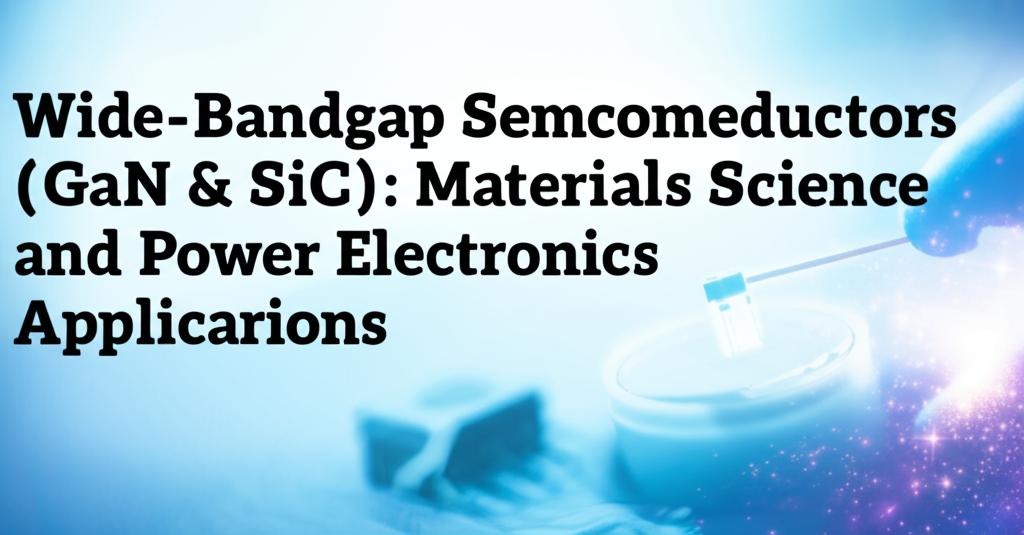Gallium Nitride (GaN) and Silicon Carbide (SiC) represent a significant leap forward from traditional silicon (Si) in semiconductor technology. These materials possess a wider "bandgap" – the energy required to excite an electron to a conducting state – compared to silicon (around 3.2-3.4 eV for GaN/SiC vs. 1.12 eV for Si). This fundamental materials science difference translates directly into superior performance for power electronics.
The Wide Bandgap Advantage Over SiliconThe wider bandgap enables GaN and SiC devices to:
- Operate at Higher Voltages: Their higher breakdown electric field strength allows devices to block much higher voltages within a smaller physical structure compared to silicon equivalents.
- Withstand Higher Temperatures: WBG materials are inherently more stable at elevated temperatures (often up to 200°C or more, compared to silicon's limit around 150°C), simplifying thermal management and increasing reliability in harsh environments.
- Switch at Higher Frequencies: Higher electron mobility (especially in GaN) and electron saturation velocity allow WBG transistors to turn on and off much faster than silicon devices. This enables higher switching frequencies (reaching MHz levels for GaN).
- Increase Efficiency: Faster switching reduces switching losses. Additionally, lower on-resistance (resistance when conducting current) minimizes conduction losses. Combined, this leads to significantly higher overall energy efficiency in power conversion.
- Boost Power Density: Higher efficiency means less heat generated, reducing the need for bulky cooling systems (like heatsinks and fans). Higher frequency operation allows for smaller passive components (inductors, capacitors). This combination enables much smaller and lighter power electronic systems for a given power rating.
While both GaN and SiC outperform silicon, they have distinct characteristics making them suitable for different application ranges:
- Gallium Nitride (GaN):
Strengths: Superior switching speed (up to 10x Si), very low switching losses, lower gate charge, excellent high-frequency performance, potential for higher integration (GaN ICs combining power stage, drive, and control), often manufactured on existing silicon (Si) wafer lines (GaN-on-Si), leading to potential cost advantages and scalability.
Typical Voltage Range: Primarily dominates low-to-mid voltage applications, typically up to 650V-900V.
Key Applications: Consumer electronics (fast chargers for laptops/phones), data center power supplies (especially 48V systems for AI), telecom power supplies, Class D audio amplifiers, LiDAR, satellite communications, onboard chargers (OBCs) and DC/DC converters in electric vehicles (EVs), robotics.
- Silicon Carbide (SiC):
Strengths: Excellent high-voltage capability (routinely 1200V, 1700V, and higher), superior thermal conductivity (better heat dissipation than GaN and Si), robustness, lower conduction losses at high power levels.
Typical Voltage Range: Preferred choice for high-voltage applications, generally 900V and above.
Key Applications: Electric vehicle traction inverters (main drive motor control), EV fast charging infrastructure, renewable energy (solar and wind power inverters, especially large-scale), industrial motor drives, power grid infrastructure, railway traction.
Materials Science and Manufacturing ConsiderationsManufacturing WBG devices presents unique challenges compared to mature silicon processes:
- Substrate Quality and Cost: Producing large-diameter, high-quality SiC wafers is complex and historically expensive, though costs are decreasing as production scales (moving towards 200mm wafers). GaN is typically grown epitaxially on other substrates like silicon (GaN-on-Si) or SiC (GaN-on-SiC), or natively on GaN substrates (GaN-on-GaN, which offers peak performance but faces cost and scalability hurdles). GaN-on-Si leverages existing silicon fabs, offering a path to lower costs, especially as wafer sizes increase towards 200mm and even 300mm.
- Defect Density: Controlling crystal defects during the growth process is crucial for device reliability and yield, and remains an area of active research and development for both materials.
- Processing Complexity: Some steps, like high-temperature processing for SiC, require specialized equipment compared to standard silicon lines.
Despite these challenges, significant progress is being made in improving yields, increasing wafer sizes, and driving down manufacturing costs, making GaN and SiC increasingly competitive.
Future Trends and Market OutlookThe market for GaN and SiC power semiconductors is experiencing rapid growth, driven by electrification (especially in automotive), the need for energy efficiency (in data centers and consumer devices), and the expansion of renewable energy. Forecasts predict strong double-digit compound annual growth rates (CAGR) for the WBG market well into the next decade, potentially reaching tens of billions of dollars.
Key future trends include:
- Cost Reduction: Continued efforts to scale production, increase wafer sizes (like 300mm GaN-on-Si), and improve manufacturing yields will drive down costs, potentially reaching parity with silicon for some device types.
- Performance Enhancement: Ongoing research aims to push voltage ratings higher (especially for GaN, with vertical GaN structures), improve efficiency further, and enhance reliability.
- Increased Integration: GaN ICs integrating gate drivers and protection features are becoming more common, simplifying design and improving performance.
- Wider Adoption: As costs decrease and reliability is proven, GaN and SiC will penetrate more mainstream applications currently dominated by silicon.
- Emerging Materials: Research continues into ultra-wide-bandgap materials like Gallium Oxide (Ga2O3) and diamond, which may offer even higher performance for future power electronics, though they face significant development hurdles.
In conclusion, GaN and SiC are transforming power electronics by enabling levels of efficiency, power density, and high-frequency operation previously unattainable with silicon. While SiC excels in high-voltage, high-power domains and GaN leads in high-speed, high-efficiency mid-voltage applications, both are critical technologies driving innovation across diverse sectors like electric vehicles, renewable energy, data centers, and consumer electronics. Continued advancements in materials science and manufacturing will further solidify their role in building a more efficient and electrified future.

